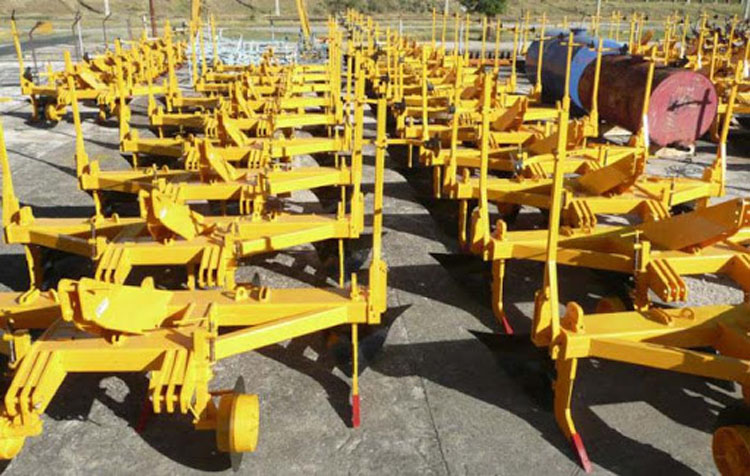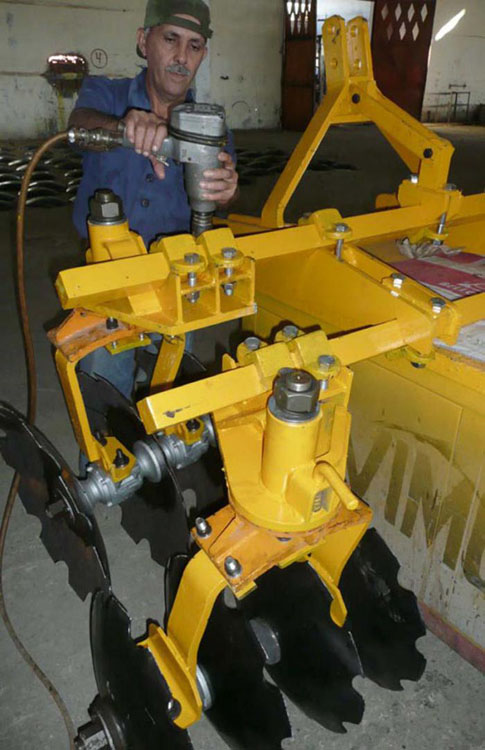HOLMECA: science and technique for Cuban Agriculture
- Written by Ania Fernández Torres
- Published in Holguin
- Hits: 1328
 Photos: Germán Veloz
Photos: Germán VelozThe modular technology for series of plows of different sizes and the links with Chinese companies have provided the specialists and technicians of the Mechanical Company Héroes del 26 de Julio (HOLMECA), the possibility of developing transporters and rice harvesters, one of the contributions of this industry to the implementation of the new economic strategy of the country.
This important entity has four base business units (UEB): the “26 de Julio” Agricultural Implements Factory; the UEB of mechanical productions of the municipality of Banes, dedicated to the boilermaking and trailers manufacturing; UEB of Tauba electric motors, in the municipality of Cacocum, which substitutes imports with the repair of motors based on alternative solutions; and the UEB for internal transport, explained Dayrelis Carrasco Rojas, communication and marketing manager.
The preparation and cultivation of agricultural soils is one of the main work objectives of the Company, which works on five projects to develop equipment and implements for these purposes, such as implements for the bioelectric plants program with Azcuba, equipment for planting work, fertilization and fumigation of grains, the development of self-propelled machines, the manufacture of electric motors and equipment for livestock.
Among these equipments, it stand out the subsoiler for works of decompressing, breaking, cultivating and plowing the sugar cane fields, which replaces the traditional discs and favors the conservation of the soils, as well as the 28-disc harrow which is integrated with 150-160HP tractors, and has a working depth of 200 millimeters and a working width of three meters.

The Company is also involved in the preparation of equipment for the composting process, which facilitate the degradation of organic matter, its mixture with other residues and additives, humification and subsequent drying and are in the design stage by the Machinery Development Center ( CEDEMA) of Holguín.
Drainage and irrigation in sugarcane plantations is one of the most complex activities of sugarcane cultivation and to humanize it, HOLMECA manufactures a specialized trencher, which can be integrated with 150-160 HP tractors for the construction of trenches. Similar results are also obtained with the sugarcane cultivator fertilizer, which allows the precise dosage of the fertilizer according to the needs of the soil.
The livestock sector can also find a solution to some of its fundamental problems with the use of new machines and technologies such as the pasture harvester silo, which allows harvesting forage in direct cut, grass, corn, sorghum and other plants for livestock feed.
Among these equipments designed for livestock farming, also stand out the pasture seeders, developed in cooperation with CEDEMA and built in China, the pasture mowers, the hay rakes and the hay baler.
To support the rice program and grain production, the Holguín company intends to develop equipment that will replace the work carried out by agricultural aviation for sowing, fertilizing and spraying, through the development of various equipment, including leveling shovel and fertilizer compost spreader.
Thanks to the experience acquired with the reconstruction of the YUMZ in the 90s and with the use of resources in their inventories, they manufactured a prototype of a tractor with a power of 60-70 HP and in accordance with the technological possibilities of the entity they have already achieved the construction of the bodywork, the cabin, front tire, bridge, pedals and other elements.
Due to the need to promote the national production of corn, the Cuban corn harvester CGC 6 is developed in cooperation with several companies and research centers of the Union of Military Industry and CEDEMA, with a high level of integration and minimal resources imported.
Of great importance for the country is also the rescue and manufacture of electric motors, mainly those developed for the Plus 2000 forage machines, imported by agriculture, a solution that can substitute large imports through future production of these machines in the country.
